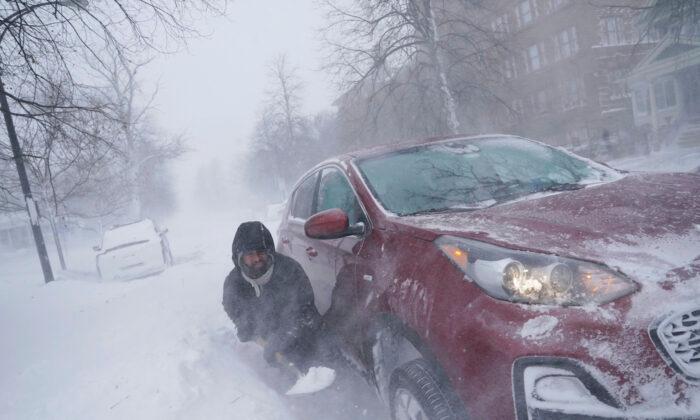COTTONWOOD, Ariz.—Winter is the best time to be prepared for road emergencies—and the worst time not to be.
The risks of not having the essential items needed for short-term survival should you become stranded are too great to ignore.
In December alone, the death toll from winter exposure has risen to 35 in Buffalo, New York, where the holiday “bomb cyclone” dumped around 50 inches of snow.
Nationwide, the storm has claimed 64 lives, primarily due to hypothermia.

The “best tip of all is to stay home when a blizzard is [in the] forecast. You can’t outdrive Mother Nature,” said Andrew Gross, public relations manager for the American Automobile Association (AAA).
Some tried—with deadly consequences.
Anndel Taylor, 22, was on her way home from work when her car became stuck in the snow outside Buffalo over the holiday weekend.
Taylor tried to wait out the storm, a decision that would prove fatal. A motorist discovered her frozen body inside the vehicle a short time later.
Kim Wright, co-owner of The Preparedness Shop in Cottonwood, Arizona, said it’s critical to be aware of winter weather forecasts and prepare for the worst.
“For those who are not woke, but awake, is you understand what’s going on around you,” Wright said.
“If you’re going to be driving in winter conditions, you need to be sure you have plenty of things to keep you warm—blankets, coats, whatever.”
Wright said staying warm includes the knowledge and the tools to build a fire, like carrying matches, or a butane lighter.
“You need fuel to be able to build a fire. You need something to be able to start a fire. You need possibly something to build a shelter if you don’t want to stay in your car,” Wright said.
A wool blanket or thermal-rated sleeping bag is also essential to maintain core body temperature in subzero weather.
According to the Centers for Disease Control and Prevention (CDC), about 600 people die yearly from hypothermia.
“Improper clothing and co-morbidities can interfere with the balance between the body’s heat production and cooling,” according to the CDC website.
“Wet clothing cannot retain body heat; warm clothing keeps the body dry and helps to decrease heat loss, which can save a person’s life during excessively cold weather.”
“Advanced age, immobility, and existing medical conditions can increase the risk for hypothermia and death during cold weather.”
Wright said staying hydrated is just as important as staying warm, which is why he recommends traveling with a few bottles of water and a portable water filtration system just in case.
Another essential item is food with a long shelf life, such as energy bars or ready-to-eat meals that require little preparation and are calorie dense.
“Food is always smart if you’re stuck for several days. MREs [Meals Ready to Eat] or something like that would be good that you can eat immediately,” Wright told The Epoch Times.
He said that having a “bug out” bag with these essential items can save lives if you have to leave home.
Other car essentials include jumper cables, a flashlight with extra batteries, flares, and a way to signal should your vehicle skid off the road, such as a hand mirror, whistle, or air horn.
“The most important thing is to be spiritually prepared,” Wright said.
AAA recommends drivers pack an emergency kit when traveling in severe winter weather.
“A well-stocked emergency kit should include a cell phone car charger, flashlight with extra batteries, first-aid kit, drinking water, extra snacks and food for travelers and pets, reflectors, an ice scraper or snow brush, shovel, warm gloves, clothes, hats and blankets for all passengers in your car,” according to a AAA advisory.
Drivers should also clean their headlights, replace old wiper blades, and check the tires’ tread depth and pressure.
“Good visibility and traction are critical when driving through winter storms or on icy roads,” AAA says.
Most of all, AAA cautions drivers to be mindful of road conditions in snow, sleet, and ice, drive slowly, and avoid hard braking.
Drivers should also avoid using cruise control in slick conditions and “making unnecessary lane changes, which increase the chances of hitting patches of ice between lanes,” the organization says.
“And the best tip of all, if there is a blizzard in your path, is to stay home. It’s a blizzard!”





